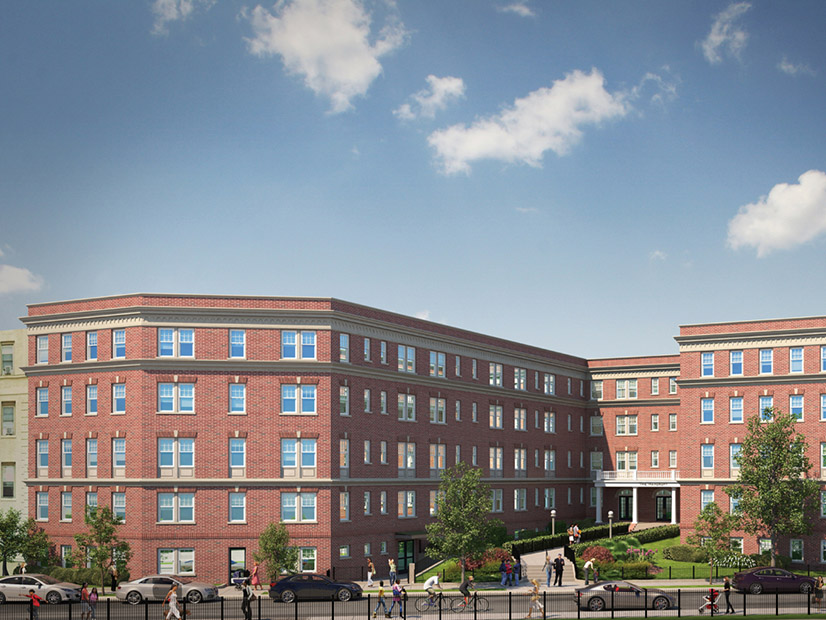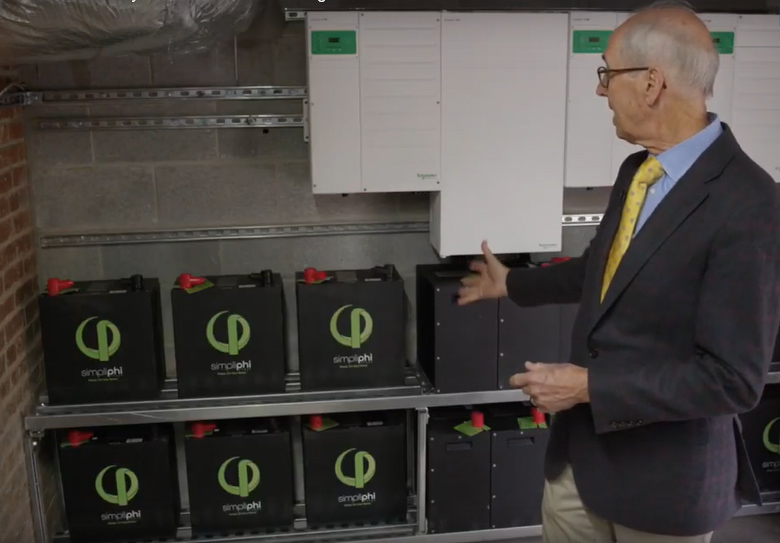
When the electric grid goes down in Washington, D.C., during the next bad storm, there is at least one apartment building that won’t be completely in the dark.
During a recent renovation, Jubilee Housing’s Maycroft Apartments, a 100-year-old low-income housing building in the capital’s Columbia Heights neighborhood, added a 70.2 kW rooftop solar array and battery storage that will power lighting for stairwells and hallways and an on-site “resiliency center” for up to three days. While residents wouldn’t have power in their units, they would be able to use the resiliency center to store medicines that need refrigeration, charge their phones, power their medical devices and watch television. The ability to shelter in place is essential for low-income residents, who cannot afford hotels or may not own cars.
In addition, 100 of Jubilee Housing’s most “rent-burdened” households will be subscribed to a community solar program that will save them $40 to $50 on their monthly electric bills for the next 15 years.
In a webinar about the project, Martin Mellett, vice president of external affairs for Jubilee Housing, the non-profit that manages the building, said a survey found about 60% of Jubilee’s residents have less than $1,000 available for all other expenses even after paying a very reduced rent. “So, a $50 a month credit on their electric bills is a huge difference,” he said. The batteries and related equipment and installation totaled $130,000; the rooftop solar array cost $197,000.

“We had planned to install solar panels anyway in this project,” Mellett said in an interview with NetZero Insider. But Jubilee and New Partners Community Solar were able to increase the ambition of the project thanks to a $9,000 grant they received in 2018 for a “technoeconomic” feasibility assessment of a solar-plus-storage system. The analysis that resulted helped win a $65,000 grant from the charitable arm of local utility Pepco to support the project — the first large-scale battery installation in D.C., according to Pepco.
Montpelier, Vt.-based Clean Energy Group (CEG), a national nonprofit, provided the initial $9,000 grant through its Technical Assistance Fund. CEG announced last month that its total grants to community organizations had surpassed $1 million since it launched the grant program in 2014. The grants are part of CEG’s Resilient Power Project, created following the widespread outages resulting from Superstorm Sandy, to increase resilience through solar plus storage.
The grants are supporting 86 affordable housing and nonprofit community organizations, representing 93 solar-plus-storage projects in 22 states, the District of Columbia and Puerto Rico, resulting in 30 completed projects to date. Almost one-quarter of TAF grant awards have resulted in completed solar-plus-storage installations; the remainder are still in the pipeline or were not viable because of economic, finance permitting or structural issues.
Grants have gone to a nonprofit mobility services provider in Colorado, affordable housing for farmworkers in California, fire stations in Puerto Rico, and a remote forestry office in New Mexico.
Connecting the Dots
The Department of Energy recently announced it is putting $16 million into such “capacity building” initiatives for low-income communities. Such communities usually lack the experience, expertise and connections to tap into the funding and technical know-how they need to do solar and storage projects.

CEG doesn’t develop projects or provide financing but connects community groups it is helping with experts on the technologies. Its role is to “help connect the dots for people, whether that’s a municipality or a community-based organization or affordable housing director,” CEG Vice President Seth Mullendore said in the webinar.
“The point of the fund is to serve low-income or otherwise disadvantaged populations,” CEG Project Director Marriele Mango said in an interview. “We rely on the nonprofit or municipal facility, and try not to be too prescriptive, but when it’s municipal we’re more specific to ensure that [the project takes place] in a disadvantaged area.”
In a typical case, “we talk about the program to our partner organizations, or someone reaches out to us, and we ask if there’s a particular facility they want a battery for,” Mango said. “We ask if there’s someone they’re working with on solar feasibility. If not, we connect them with such a developer on the scope of work and the timeline and check if they’re eligible for the funds. We’re in a supportive role — we ask questions and support the community group.”
CEG asks the community partner for electric bills and load data, Mullendore said. “Sometimes the technical assistance provider can build and work as the developer, but in most cases, we prefer to work with a non-invested, third-party developer that is not tied to one specific vendor. In the post-analysis assessment process, we check in to see if there’s anything we can do to help. We help get the word out, so we can write up a case study or do a webinar, so other folks can learn from their project.”
Common Challenges
Many smaller, grassroots groups lack information about resilience, Mango said. “They may know about solar generally, but don’t know that when the grid is off, solar doesn’t continue to power the building. We educate them on how a battery operates and can support your building.”
Other problems may arise after the grant has been made and the project is being implemented. “Often, on the assessment side, there are changes in the scope, for example to replace an HVAC system, or add EV charging,” Mullendore said. Since many of the projects take place in existing buildings that are being rehabilitated, “there can be very interesting and complicated electrical system problems,” he added. “Permitting standards can vary. On implementation, the biggest problem is funding, how to pay for the systems. So, we have to look at revenue, saving people money. Usually, there’s a funding gap. We don’t have money from foundations, except for the $3 million Kresge Foundation loan guarantee program.”
Another resiliency hub CEG helped set up is on the other side of the country, in Santa Rosa, Calif., home of the California Indian Museum and Cultural Center. The museum awoke to the need to help its community in that way when the area was devastated by the 2017 Tubbs Fire, and museum staff were handing out water to displaced people in the building’s parking lot.
CEG helped the museum find consultants to advise on how to set up the resiliency center, including the permitting and installation, Nicole Lim, executive director of the museum, said in an interview. CEG also worked with the tribal community to advise them on “different types of systems to help them get access to green infrastructure,” she said. “This is in line with our cultural values of environmental stewardship.”
The resiliency center already has served the community during power shutoffs Pacific Gas & Electric has imposed for up to a week to reduce the danger of its transmission lines sparking more wildfires.
Mango said interest in the Technical Assistance Fund has expanded to new parts of the country each year, an indication of the breadth of the climate crisis, “with more places impacted by severe weather and power outages than ever before.”
CEG is hoping to raise funds to award another $1 million over three years. “We had not widely advertised the program before,” Mullendore said. “We have worried about being overwhelmed, because we could probably increase tenfold to meet the demand we’ve seen, which increases every year.”
